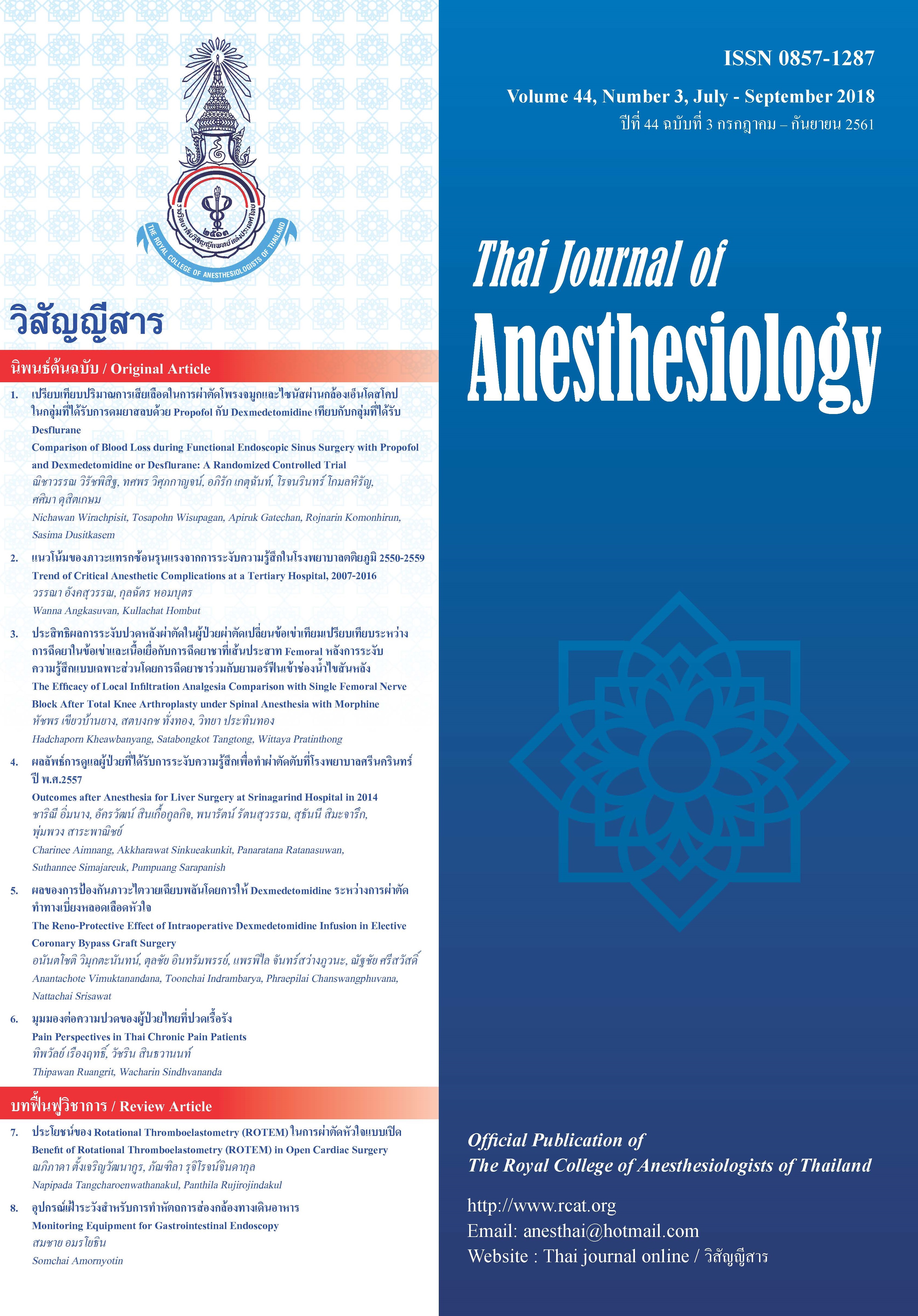Comparison of Blood Loss during Functional Endoscopic Sinus Surgery with Propofol and Dexmedetomidine or Desflurane: A Randomized Controlled Trial
Main Article Content
Abstract
Background: Poor visualization due to bleeding during endoscopic sinus surgery leads to bad outcomes. Anesthetic technique is one of the most important factors to reduce blood loss. However, no definite conclusion
whether which technique is the best. This study aimed to compare inhalation anesthesia technique (desflurane) with total intravenous anesthesia technique (dexmedetomidine and propofol) on blood loss and surgical field condition. Method: A prospective, randomized controlled study was conducted in 40 patients undergoing elective endoscopic sinus surgery. They were randomly assigned into 2 groups: desflurane group (N=20) and dexmedetomidine and propofol group (N=20). The target mean arterial pressure (MAP) was maintained at 65-75 mmHg. Visibility of surgical field is rated numerically (1-10). The primary outcomes were intraoperative blood loss and surgical field conditions. Secondary outcomes were pain scores at the recovery room and the day after surgery. Result: Forty patients were enrolled. One patient in dexmedetomidine and propofol group dropped out
due to asthmatic attack during the operation. Baseline characteristics were not different between two groups. Total blood loss was not different between two anesthetic techniques. Visualized surgical fields were similar. Dexmedetomidine combined with propofol group seemed to have low pain score but not different. Conclusion: This study cannot demonstrate the effect of propofol and dexmedetomidine based anesthesia on reduction of blood loss in endoscopic sinus surgery. The preoperative discussion of anesthesia technique preferences between the surgeon and the anesthesiologist may be necessary.
Article Details
References
2. Milonski J, Zielinska-Blizniewska H, Golusinski W, Urbaniak J, Sobanski R, Olszewski J. Effects of three different types of anaesthesia on perioperative bleeding control in functional endoscopic sinus surgery. Eur Arch Otorhinolaryngol 2013;270(7):2045-50.
3. Marzban S, Haddadi S, Mahmoudi Nia H, Heidarzadeh A, Nemati S, Naderi Nabi B. Comparison of surgical conditions during propofol or isoflurane anesthesia for endoscopic sinus surgery. Anesth Pain Med 2013;3(2):234-8.
4. Chaaban MR, Baroody FM, Gottlieb O, Naclerio RM. Blood loss during endoscopic sinus surgery with propofol or sevoflurane: a randomized clinical trial. JAMA Otolaryngol Head Neck Surg 2013;139(5):510-4.
5. Boonmak S, Boonmak P, Laopaiboon M. Deliberate hypotension with propofol under anesthesia for functional endoscopic sinus surgery (FESS). Cochrane Database Syst Rev 2013;06(6):CD006623.
6. Snidvongs K, Tingthanathikul W, Aeumjaturapat S, Chusakul S. Dexmedetomidine improves the quality of the operative field for functional endoscopic sinus surgery: systematic review. J Laryngol Otol 2015;129Suppl3:S8-13.
7. Karabayirli S, Ugur KS, Demircioglu RI, et al. Surgical conditions during FESS; comparison of dexmedetomidine and remifentanil. Eur Arch Otorhinolaryngol 2017;274(1): 239-245.
8. Beule AG, Wilhelmi F, Kühnel TS, Hansen E, Lackner KJ, Hosemann W. Propofol versus sevoflurane: bleeding in endoscopic sinus surgery. Otolaryngol Head Neck Surg 2007;136(1):45-50.
9. Snidvongs K, Tingthanathikul W, Aeumjaturapat S, Chusakul S. Dexmedetomidine improves the quality of the operative field for functional endoscopic sinus surgery: systematic review. J Laryngol Otol 2015; 129 Suppl 3:S8-13.
10. White PF, Eng MR. Intravenous Anesthetics. In: Barash PG, Cullen BF, Stoelting RK, Cahalan MK, Stock MC, Ortega R. Clinical Anesthesia. 7th ed. Philadelphia, PA: Wolters Kluwer Health/Lippincott Williams & Wilkins; 2013. p. 478-500.


